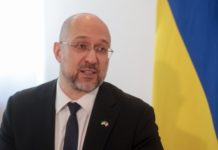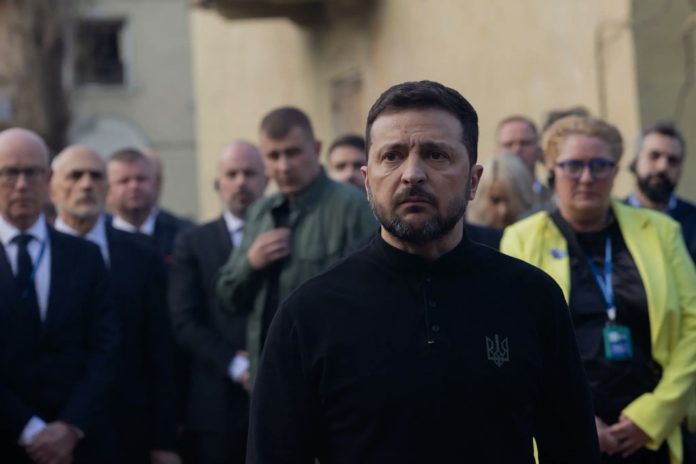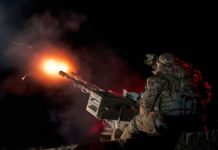Over the past 24 hours, the Armed Forces of Ukraine recorded 200 combat engagements, particularly in the Pokrovsk, Lyman, and Novopavlivka directions. Russia carried out over 6,100 attacks using artillery, drones, and aircraft. Ukrainian defenders are holding the line and inflicting significant losses on the enemy.
On the diplomatic front, discussions on ceasefire conditions continue. In Germany, political leadership changed: new Chancellor Friedrich Merz confirmed his support for Ukraine. Ukrainian air defense shot down 54 Shahed drones overnight on May 6, while 70 more lost direction and failed to reach targets.
Frontline Situation
As of May 6, 2025, the 1168th day of the full-scale war, combat remains extremely intense across the front. A total of 200 clashes were recorded in key directions, alongside over 6,100 shellings, including 113 from MLRS. Russian forces continue to widely use attack drones and aircraft.
- Pokrovsk direction: 78 enemy attacks during the day (36 more since midnight), including near Sukha Balka, Shevchenko, Kotliarivka, Andriivka, Novosergiivka, Malynivka, and Pokrovsk.
- Lyman direction: 31 attacks near Torske, Myrne, Kolodiazi, and Zelena Dolyna. In the morning, another 8 attacks near Lypove, Ridkodub, and Novyi Myr.
- Kupiansk direction: 5 enemy assaults and new attempts to break through near Zahryzove and Petropavlivka.
- Kramatorsk direction: 4 attacks repelled near Chasiv Yar and Kurdiumivka. Morning clashes continue.
- Toretsk direction: 6 enemy attacks near Toretsk, Ozarianivka, and Dachne.
- Novopavlivka direction: 24 enemy assaults in a day, with 14 more in the morning near Kostiantynopil, Vilne Pole, and Odradne.
- Hulyaipole and Orikhiv directions: intense fighting with at least 21 enemy attacks, plus airstrikes (KABs) on Hulyaipole, Mala Tokmachka, and Kamianske.
- Kursk direction: over 330 artillery strikes, 12 airstrikes, and extensive drone use.
- No active operations were recorded in the Siversk, Dnipro, Volyn, and Polissia directions.
Overnight on May 6, the enemy launched a massive drone attack with 136 UAVs: 54 were shot down, and 70 lost orientation. Kharkiv, Odesa, and Dnipropetrovsk regions were hit.
The enemy is focusing efforts on breaching Ukrainian lines in Donetsk region, especially near Pokrovsk. Despite intense strikes, Ukrainian forces are holding and destroying large numbers of enemy UAVs, artillery, and manpower.
Russian Losses
As of May 6, 2025, Russia’s total losses since the invasion began include:
- Personnel: approximately 959,500 (+1,430 over the past day)
- Tanks: 10,766 (+3)
- Armored combat vehicles: 22,416 (+5)
- Artillery systems: 27,431 (+61)
- MLRS: 1,378 (+1)
- Air defense systems: 1,155 (no change)
- Aircraft: 372 (no change)
- Helicopters: 335 (no change)
- Tactical UAVs: 35,142 (+145)
- Cruise missiles: 3,196 (no change)
- Warships/boats: 28 (no change)
- Submarines: 1 (no change)
- Vehicles and fuel tanks: 47,353 (+103)
- Special equipment: 3,873 (+3)
The enemy suffered particularly heavy losses in artillery, UAVs, and logistics — a result of Ukraine’s effective counter-battery fire and air defense coordination.
Ukrainian Strikes and Battlefield Achievements
Ukrainian aviation and artillery remain highly active. Over the past day:
- 24 enemy personnel and equipment concentrations were struck.
- 2 command posts and at least 5 artillery systems were destroyed.
- 2 air defense systems were neutralized.
- 4 other rear support targets were disabled.
In addition, mobile fire teams and air defense forces downed 54 strike UAVs attacking from the north, east, and south.
Targeted strikes on key enemy assets help Ukraine degrade Russia’s offensive potential and disrupt its advance plans.
Diplomatic Developments
Between 12:00 on May 5 and 12:00 on May 6, 2025, diplomatic efforts surrounding the war in Ukraine remained active. Key developments included discussions on new peace proposals, leadership changes in Germany, and statements regarding NATO’s future role.
- UK Prime Minister Keir Starmer met with French President Emmanuel Macron on May 5. The two leaders discussed the current situation in Ukraine and potential paths toward peace. While details were not disclosed, both reaffirmed their commitment to supporting Ukraine and pursuing diplomatic solutions.
- Former German Ambassador to the U.S. Wolfgang Ischinger warned that forming European peacekeeping forces in Ukraine without U.S. involvement could undermine NATO unity. He stressed that such actions might provoke Russia and threaten European security.
- Friedrich Merz was elected as Germany’s new chancellor on May 6. His platform includes stronger support for Ukraine, increased defense spending, and enhanced transatlantic ties. Germany is expected to maintain active participation in peace initiatives.
- U.S. President Donald Trump stated that falling oil prices create favorable conditions for a peace deal between Ukraine and Russia. He believes both sides are interested in ending the conflict.
Diplomatic efforts continue to intensify amid leadership changes and ongoing international dialogue. However, as Ischinger noted, any moves excluding major allies like the U.S. may destabilize European security and NATO cohesion.
International Support for Ukraine
As of May 6, 2025, Ukraine is receiving fresh signals of support from key international partners. The focus remains on defense assistance, pilot training, aviation modernization, and diplomatic initiatives related to European security.
- The United States approved a new $310 million agreement to modernize Ukraine’s F-16 fleet. For the first time, the deliveries are part of an investment fund linked to Ukraine’s mineral extraction sector. The package includes maintenance, equipment, and related services.
- The Netherlands is sending two additional Patriot air defense systems to Ukraine. The decision follows heavy drone attacks on Kharkiv and Odesa regions. Delivery is scheduled for mid-May, as confirmed by the Dutch Defense Minister.
- The Czech Republic is expanding its pilot training program for Ukraine. Prague is increasing the number of instructors and training facilities for F-16 pilots and providing new supplies of artillery ammunition.
- Ukrainian President Volodymyr Zelensky received a confirmation of support from newly elected German Chancellor Friedrich Merz. In his congratulatory message, Zelensky expressed hope for strengthening defense and diplomatic partnership with Berlin.
- The EU and the United Kingdom have agreed to hold annual summits focused on Ukraine’s security and support. The initiative aims to coordinate military aid, align sanctions, and develop long-term strategic planning.
Ukraine continues to benefit from consistent Western support. New defense contracts, training programs, and diplomatic formats highlight the unwavering commitment of partners to strengthen Ukraine’s defense capabilities and support its path to victory.
Humanitarian Situation in Ukraine
The humanitarian situation remained critical in several regions due to mass drone strikes, air raids, and shelling from Russian territory. Civilians, critical infrastructure, and residential areas were severely affected.
- Overnight on May 6, Russian forces launched 136 drones at Ukraine: 54 were shot down, and 70 failed to reach targets. Kharkiv, Odesa, and Dnipropetrovsk regions suffered the most damage. Power grids, industrial warehouses, and residential neighborhoods were hit.
- In Sumy region, at least 14 settlements came under fire, including Novodmytrivka, Stepok, Bila Bereza, Ulanove, and Porozok. The enemy used artillery, MLRS, and guided bombs.
- In Dnipropetrovsk region, multiple homes were destroyed in a drone strike. Two people were injured, and one woman was killed (preliminary data). Rescue operations are ongoing.
- In Odesa region, drone fragments damaged port infrastructure and private households. One civilian was hospitalized with moderate injuries.
- In Kharkiv, electricity and water outages were reported due to damage to substations. City authorities deployed heating points and emergency water supplies.
- International organizations including the UN, Red Cross, and World Central Kitchen delivered aid to affected areas in Sumy and Dnipropetrovsk. This included food packages, medicine, and materials for housing repair.
Russia continues to target Ukraine’s civilian infrastructure. Government and humanitarian partners are responding swiftly to support the most affected populations.
Domestic Situation in Ukraine
As of May 6, 2025, Ukraine’s domestic agenda is focused on addressing social, mobilization, and economic challenges. The government continues to implement labor reforms, housing reconstruction efforts, and improve the mobilization process amid the ongoing war. While citizens face growing hardships, support programs are showing increased effectiveness.
- Social policy and reconstruction: A new phase of housing compensation has begun in Kyiv, Kharkiv, and Kherson regions for those whose homes were destroyed or damaged by Russian attacks. Applications can be submitted via Diia or local centers. Compensation amounts up to UAH 200,000.
- Labor reform: The government launched a broad labor market reform aimed at reducing unemployment, enhancing worker qualifications, and reintegrating veterans into civilian life. Measures include educational grants and business incentives for hiring IDPs and combatants.
- Decline in unemployment: According to Info Sapiens, the unemployment rate fell to 12.1% in March 2025 — the lowest since the full-scale invasion began. However, over 24% of Ukrainians are forced to cut spending on essentials, including food.
- Mobilization reform: New rules are being enforced — the draft age is lowered to 25, an electronic registry of conscripts is introduced, and payments for contractors are increased. Compensation is also planned for families of mobilized individuals.
- Social tensions: Conflicts between conscription offices and civilians have been reported in several regions. Authorities documented cases of forged documents and attempted illegal border crossings to evade service. The Ministry of Internal Affairs has increased border controls.
Ukraine is continuing to adapt to the demands of long-term war by reforming the labor market, enhancing mobilization systems, and sustaining humanitarian response. Internal stability remains a critical condition for national resilience.
Conclusion
May 6, 2025 confirmed key war trends: the intensity of fighting in Donbas is rising, but Ukrainian forces are holding their ground and inflicting major losses. Despite mass drone and artillery attacks, Ukraine’s air defense continues to perform effectively.
Alongside battlefield dynamics, international support remains strong — particularly from the EU and U.S. Diplomatic initiatives are intensifying, but there are no signs of real readiness for peace talks. Ukraine’s domestic situation remains under control despite pressure on social and mobilization systems.
Conclusion
As of May 5, 2025, Ukraine firmly maintains its defense, effectively resisting enemy pressure. Russia continues to suffer severe losses. Diplomatic momentum is building, and international partners remain engaged. Internally, Ukraine demonstrates growing economic stability and resilience — strengthening its capacity to withstand ongoing wartime challenges.
🤝 SUPPORT US 💙💛
We continue to work only because you read and support us. If you appreciate what we do, please become our sponsor or donate here👇
☑️ patreon.com/MeanwhileinUkraine
or
☕️ buymeacoffee.com/meaninuak
Your support helps us continue delivering timely and accurate updates. Stay informed and stand with Ukraine! 🇺🇦
Together we are stronger! 🇺🇦
























